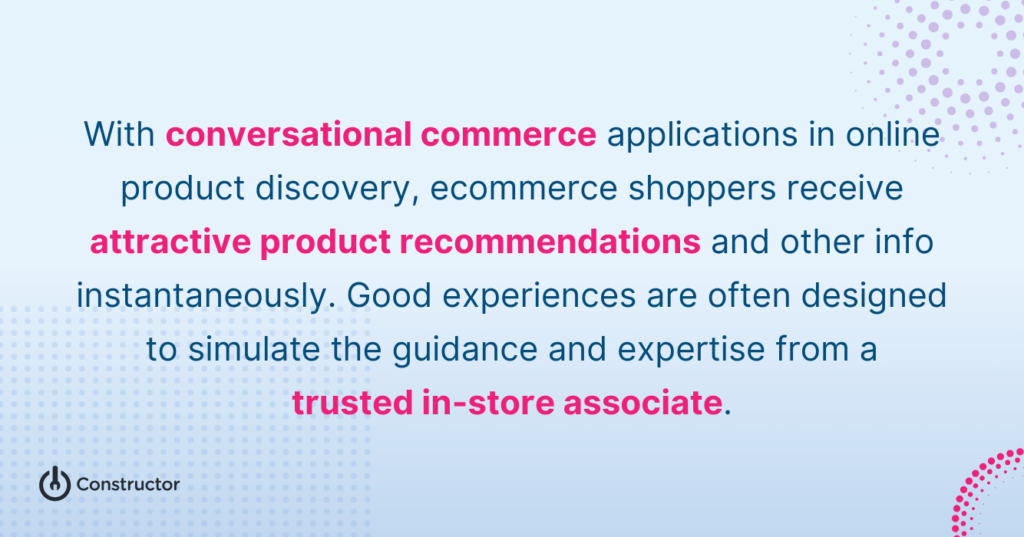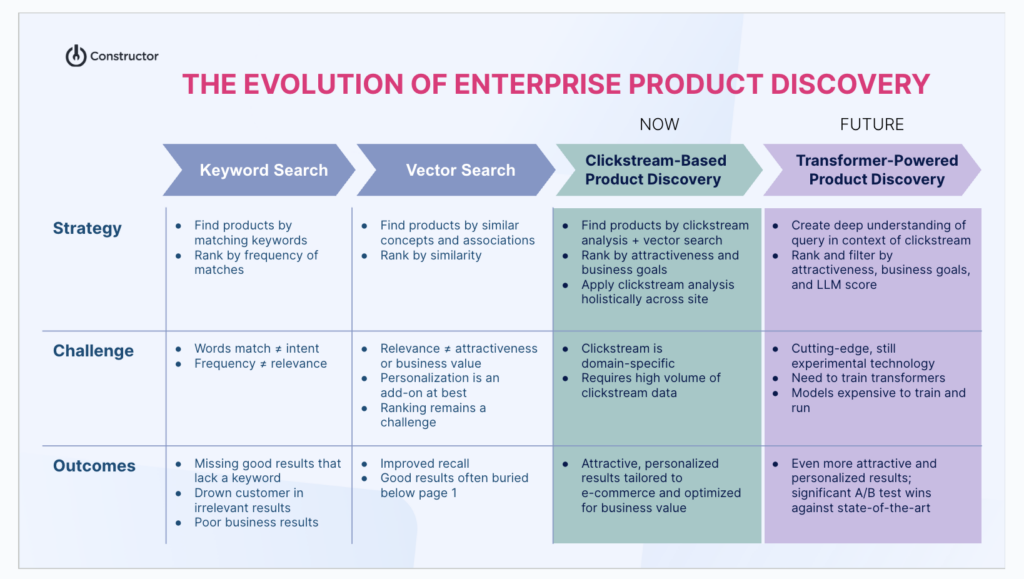The ecommerce industry has seen a breakneck pace of change in the last decade, driven in large part by technology innovations. From a surge in mobile and social commerce to AI-based personalization and more, ecommerce companies have tapped into technology to stay competitive, keep pace with shoppers’ needs, and improve the customer experience.
As of late, conversational commerce has become an important part of the ecommerce product discovery vernacular and toolkit. With the market for conversational commerce expected to reach $4.9 trillion (USD) by 2028, more ecommerce companies are acknowledging its potential to help online customers receive quicker, more personalized product recommendations at scale — in a way that benefits the bottom line.
If you’ve been wondering about the technology and its ability to benefit your business, we’ve provided a primer.
What is Conversational Commerce?
Definition time, first. At its core, conversational commerce is what the name implies: conversational interfaces and technologies that advance the buyer journey and facilitate online and mobile sales. Messaging and chat apps, AI chatbots, voice commerce, social messaging apps, and text messaging all fall under the conversational commerce umbrella and have an important role in product discovery.
Conversational commerce also brings the promise of immediacy to buyers, even outside of business hours. Forget inputting your name, contact info, and query into a (black hole?) web form and waiting two to five business days for a response.
With conversational commerce applications in online product discovery, ecommerce shoppers receive attractive product recommendations and other info instantaneously. Good conversational commerce experiences are often designed to simulate the guidance and expertise a buyer might receive from a trusted in-store associate.
The History of Conversational Commerce
While the concept, underlying technologies (messaging apps, conversational interfaces, smartphones, etc.), and even execution predate the term, “conversational commerce” as a phrase is largely believed to have been coined almost a decade ago by Chris Messina, inventor of the hashtag and a former developer experience lead at Uber.
With Facebook having just acquired WhatsApp, and voice assistants such as Amazon Alexa having been newly released, there was a big appetite and opportunity to harness conversational technologies to drive sales. Messina set out his observations and impressions, writing in 2015: “Conversational commerce is about delivering convenience, personalization, and decision support while people are on the go, with only partial attention to spare.”
He elaborated in an article the following year, noting that conversational commerce “largely pertains to utilizing chat, messaging, or other natural language interfaces (i.e. voice) to interact with people, brands, or services and bots that heretofore have had no real place in the bidirectional, asynchronous messaging context.”

Types of Conversational Commerce
Across the buyer journey, ecommerce companies employ conversational commerce to answer product questions, help buyers discover products and content, and expose buyers to new, attractive items. Experts largely group conversational commerce into distinct categories, including:
- Social messaging apps. Apps such as Facebook Messenger, WhatsApp, Snapchat, and WeChat facilitate dialogue and transactions between brands and consumers.
- Voice assistants/ voice commerce. Amazon Alexa, Apple’s Siri, and Google Home use technologies including natural language processing (NLP), automatic speech recognition, and AI and machine learning to process voice inputs and facilitate sales.
- SMS marketing. With near-instant deliverability and high open rates, text messages are an increasingly popular way for businesses to reach customers: sending deals and promotions, product alerts (e.g., “now back in stock!”), shipping updates, surveys, appointment reminders, and more. Data shows 71% of shoppers have signed up to receive texts from businesses within the last year, and nearly 9 in 10 businesses (86%) use text message marketing to reach their customers.
- Live chat. Typically manned by human agents, live chat enables consumers to initiate chat sessions — usually via a pop-up or sidebar — and get timely answers to sales, support, and other inquiries.
- Chatbots. Chatbots are AI-based computer programs designed to engage with humans, responding to online queries in a way that mimics natural, human conversation. They’re often integrated into websites, mobile apps, and customer service systems to provide immediate assistance and support. Thanks to advancements in NLP and other forms of AI, chatbots have come a long way in recent years!
The evolution of the chatbot
Many buyers (and companies alike) may have not-so-fond recollections of early and traditional chatbots. These types of bots can be limited in functionality and value, sometimes causing frustration among users.
Relying on forms or complex if-then logic, they’re often configured to only handle “frequently asked questions” before requiring a human agent to intervene — hindering the bots’ effectiveness when addressing a broad range of product-related and other queries.
But don’t let poor experiences color your impressions of chatbots or conversational commerce.
The advent of advanced AI technologies has driven an important evolution that significantly extends chatbots’ value and the use cases they can address, particularly in helping customers find the right products for them.
In fact, Messina postulated in his 2016 article that “computer-driven bots will become more human-feeling, to the point where the user can’t detect the difference, and will interact with either human agent or computer bot in roughly the same interaction paradigm.”
The statement is proving prescient!
The Impact of Solutions Powered by Generative AI and Transformers
Innovative ecommerce companies today are using emerging technology such as transformers (the “T” in ChatGPT) to facilitate more human-like, accurate interactions in their chatbots and across all facets of product discovery.
Built on a deep learning architecture with an NLP model, transformers can accurately interpret the importance and context of each term in a query. This makes them extremely useful for processing long-form language.
So, rather than search for “triathlon gear,” an online shopper could search: “I’m doing a triathlon for the first time this May in Boston. What type of gear do I need?” With transformers, not only would this query be understood, but product and content results surfaced are also instantly tailored to the shopper’s needs.
When trained on large ecommerce data sets and used in tandem with first-party clickstream data as context, transformers allow ecommerce companies to understand shopper intent on a deeper level, while also ranking products in a way that’s more attractive to the individual user and optimized for business KPIs.
Thanks to capabilities such as these, transformers and the larger field of Generative AI — of which transformers are a part — have given rise to a new paradigm in ecommerce product discovery: where shoppers can express complex needs (no need to search in terse language, just using keywords) and receive instant, spot-on recommendations.
Constructor’s AI Shopping Assistant (ASA)
Constructor’s AI Shopping Assistant (ASA) is a conversational commerce and product discovery tool that goes beyond traditional chatbot.
Often embedded within ecommerce sites’ search bar or chat, ASA enables buyers to express long-form requests and engage in conversations to receive product recommendations that make sense contextually, are personalized to them, and align to the site’s real-time inventory.
ASA also provides support for other types of results (e.g., content like articles, guides, and multimedia) within an intuitive user interface and results display, among other features.
The online publication Talk Commerce recently described how Constructor is using GenAI to unlock new possibilities in conversational commerce, noting: “With the launch of its AI Shopping Assistant (ASA) last fiscal year, Constructor became the first product discovery provider to integrate conversational, generative AI. … Constructor realizes the amazing potential of generative AI to provide ecommerce companies with even more tailored, engaging search and discovery capabilities.”
Many ecommerce companies spanning various industries are already taking advantage of ASA today, implementing the tool for the following use cases:
- Grocers use ASA to generate recipes in response to search queries, providing a list of in-stock and personalized ingredients.
- Fashion & apparel retailers use ASA to recommend personalized and occasion-specific apparel (e.g., “What can I wear to a formal wedding in the Caribbean in August?”).
- General retailers use ASA to help shoppers surface items across categories that meet their needs (e.g., “Help me find camping supplies for my first weekend camping trip with my pre-teens.”).
Results from ecommerce companies who implement the solution include a 10% increase in website revenue, 6% increase in search conversions, 7% increase in clicks, and more.
Check out additional types of queries ASA can support in the video below, or click here:
Let’s Talk About Conversational Commerce
As ecommerce companies get started with conversational commerce, it’s important to first ask: “What type of experience are we trying to create?” That will dictate the types of conversational commerce tools you employ.
Of equal importance is asking upfront: “What value do we expect to derive?” Rather than apply GenAI and conversational commerce in a way that’s just flashy, with little substance behind the glitz, it’s instead important to take an approach that’s utility-driven and builds customer relationships.
Check out more ways to use Constructor’s AI Shopping Assistant to improve your product discovery experience and bottom line in our age of waning brand loyalty and increased competition.


